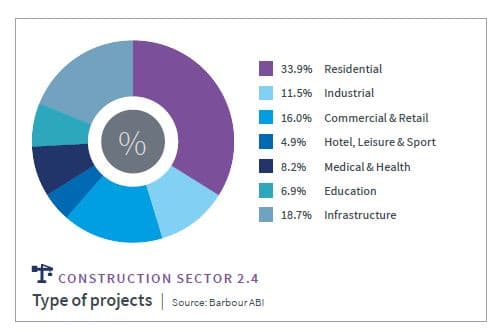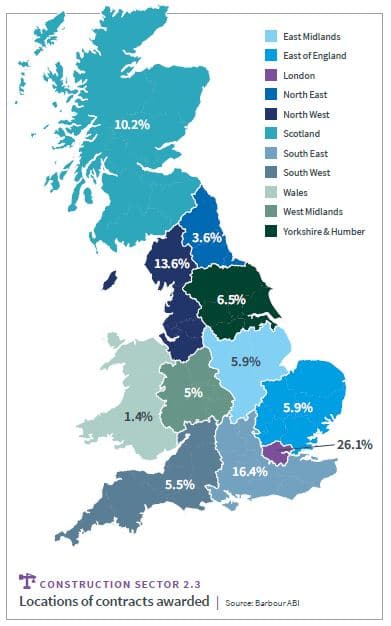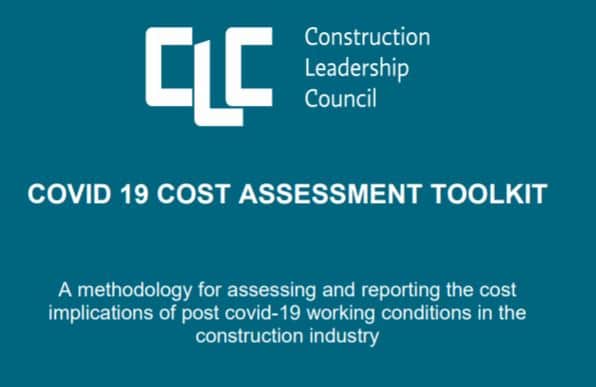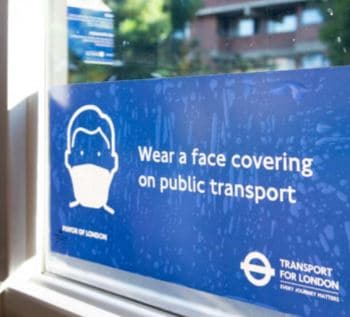
Barbour ABI: Contract awards on the up
Construction overview
According to Barbour ABI data, the total value of construction contract awards in June was £2.2 billion based on a three month rolling average.
Compared to May 2020, this is a decrease of 9.2% and is also 57.3% lower than June 2019 (see fig. 2.1). Data for Q2 2020 shows that total construction contract awards are valued at £9.2 billion. This is 51.3% lower than Q1 and also 40.5% lower than for Q2 2019. However, the raw monthly data for June is positive with value increasing by 98% compared with May.
In terms of contract award numbers, June 2020 was positive with 81.4% increase to 477 compared with just 263 in May. Whilst the three month average data is still influenced by the significant decrease in April, the raw monthly data and the increase in contract numbers in June are beginning to signal improving conditions.

Project by region
Regional analysis shows that London had the largest share of contract awards in June at 26.1%. The South East was in second place with attributable share of 16.4% of awards and was followed by the North West in third place with 13.6% of contract awards. Wales was again the smallest region with just 1.4% of awards (see fig. 2.3).
Three contract awards were vying for top award status in June and were all valued at £150 million. In Crawley, the Gatwick Airport Station refurbishment project will see Costain Group extend the existing concourse as well as provide extra platforms. This 36 month project is due to be completed in April 2023. In Manchester, the City View Development – Regent Plaza involves the building of 525 residential units in a 26 storey building. This 40 month project is due for completion in Q3 2023 and was awarded to Helix Contracting. Located in Milton Keynes the Santander New Tech Hub Campus is the new eight storey UK headquarters building for the bank. Awarded to John Sisk & Son the project is due for completion in Q1 2023.
Types of project
Attracting 33.9% of all construction contract awards the residential sector retained lead status in June. The second largest sector this month was infrastructure which accounted for an 18.7% share of awards.
Commercial & retail was the third largest sector in June accounting for 16.0% of awards. Apart from City View Development Regent Plaza, other notable residential awards this month included the former Lea Castle Hospital Development in the West Midlands valued at £60 million which will provide 600 units. Renewable energy generation featured heavily in infrastructure awards this month including the £75 million 75.5MW Aikengall 11a Wind Farm in the Scottish borders. Within the commercial & retail sector a notable mixed use project was the Tri Sail Towers development in Bishop Stortford valued at £19 million.
The report identifies that, in the commercial and retail sector, MACE and ISG were the leading way in terms of value of contract awarded, McAleer & Rushe Ltd and Willmott Dixon top the table for, Hotel, Leisure and Sport; Balfour Beatty and Integrated Health Projects were the most successful in the Medical and Health sector and Morgan Sindall and Kier for Education.
To see the full report and detailed analysis of the Residential, Commercial and Retail, Hotel, Leisure and Sport, Industrial, Medical and Health and Education Markets including details of key clients, architects and contractors click here.





